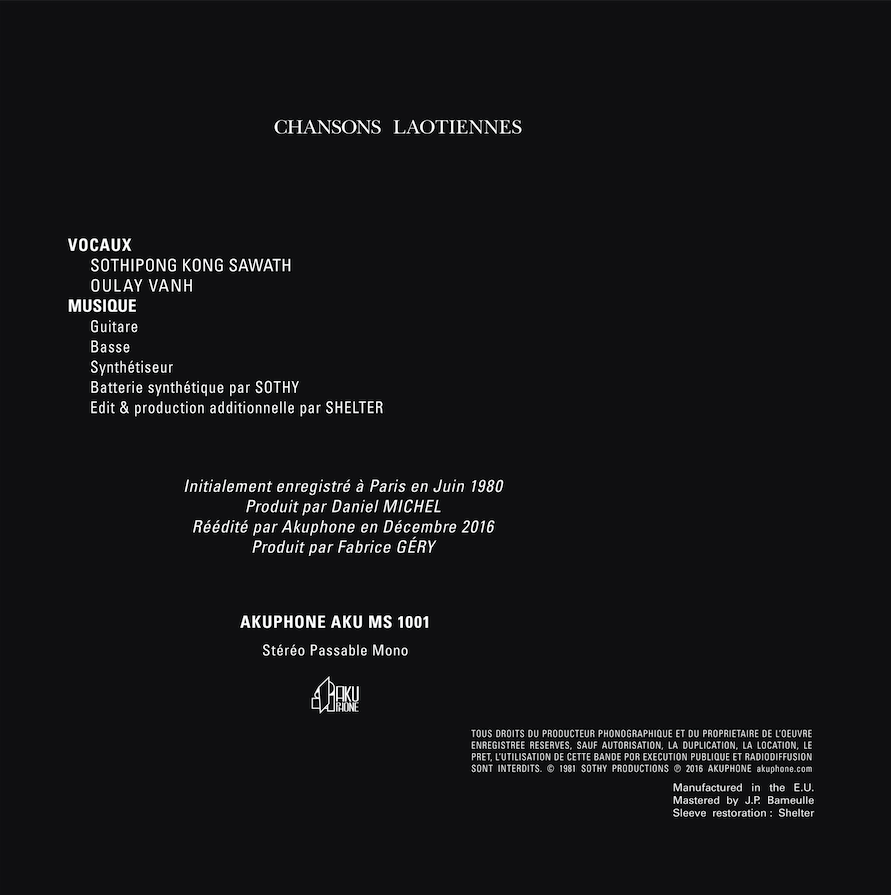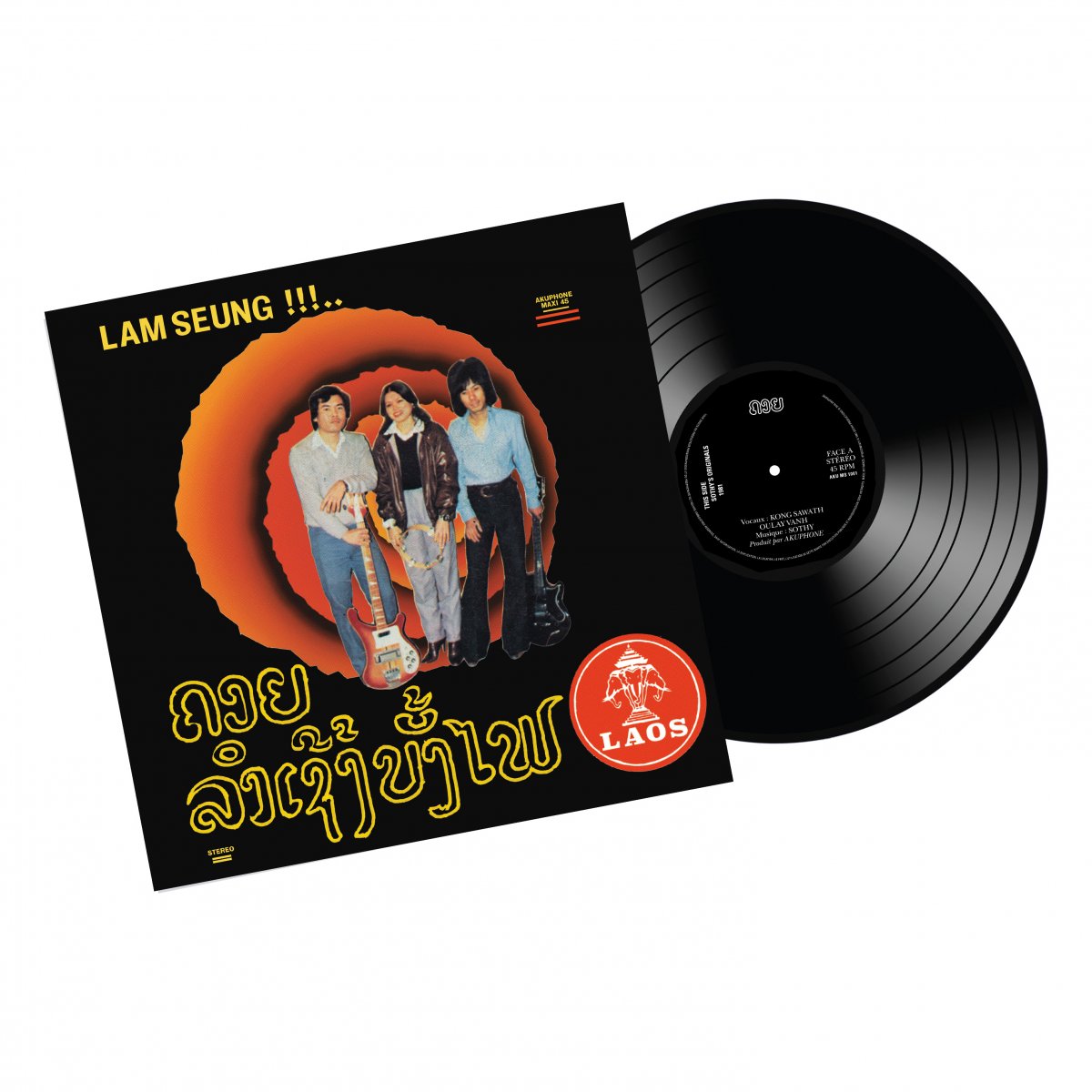Sothy : Lam Seung !!!.. Chansons Laotiennes
4,90€ - Buy Digital 11,90€ - Buy Vinyl
- Rare cosmic Lao synth pop
- Produced by SOTHY
- Recorded in Paris 1980.
- Original remaster + extended edit by SHELTER.
- Sawathdi nongsao ca pai nai sai sua si daeng? »
- Hello young lady, where are you going all dressed in red? »
- Ya wun ya wai, nong ca pai thiew bunbangfai »
- I don’t want to get into trouble. I’m going for a walk at the rocket festival. »
Slow paced drums with offbeats softly phased with the guitar, misty takeoffs from the synthesizer: a hazy idyll is starting off on the road to the rocket festival (bun bang fai). Answering each other on the responsive mode of the lam soeng, Sothipong engages in a flirt but Oulay Vanh is not ready to trifle with just anybody. As a stylistic variation of a popular Lao musical genre, the lam soeng was the source of several themes among which the “bang fai” - which is part of the Lao conciliatory festivities preceding the rainy season - remains one of the most renowned. However, the producer and composer of these songs, Sothy, created an unusual arrangement: the instrumental introduction separates from the sang canon, the synthetic mix is stripped down of the traditional organology - everything here becomes unsettling for a listener familiar with the genre. Everything comes with a reason: the record was edited in 1981 under the title Sothy Productions yet produced in France by the Parisian label Oxygène (famously known for its unforgettable first French punk compilation 125 grammes de 33 1/3 tours). Chansons Laotiennes still remains hard to classify.
And then who’s Sothy? Along with the unverifiable identity of the seemingly Laotian singers, skepticism gains ground concerning the man behind the pseudonym. Is he an escaped musician from one of the first Cambodian rock bands of the 1960s? A surviving producer from the 1980s Paris? Or a composer in transit in one of the many places of the Laotian diaspora? Sothy eludes any researches and disappears behind his numerous homonyms. The second track is just as enigmatic: a beat box, a lightly reverberated voice as well as a guitar solo and a small synthesizer break, “Tuei” or “Tawai” [offering] (as the writing on the record suggests) makes way to dancing step and a truly joyful melody. Twisted and lively steps on a romantic background tune turn this second track into a genuine paslop - a program recommended by therapists to relieve muscular pains due to seated positions: you will unlock your pelvis with some synchronized Laotian choreographies.
For their first edits, Akuphone called on a young Parisian producer. Shelter, aka Alan Briand, mingles his own mixes and electro productions with a large variety of influences and styles: krautrock, disco, traditional music, psychedelic, synth pop, ambient, bossa nova, Japanese funk. He produces both original compositions and remix. Here is the first Akuphone’s maxi single!
- Sawathdi nongsao ca pai nai sai sua si daeng? »
- Salut jeune fille, où vas-tu vêtue de rouge ? »
- Ya wun ya wai, nong ca pai thiew bunbangfai »
- Je ne veux pas d’ennuis, je m'en vais promener au festival des fusées. »
Batterie à la mécanique lente, contre-temps légèrement phasés à la guitare, envolées nébulées d'un synthétiseur : une idylle vaporeuse s'engage sur la route du festival des fusées (bun bang fai). Se répondant l'un l'autre sur le mode responsorial d'un lam soeng, Sothipong flirte, mais Oulay Vanh ne badine avec n'importe qui. Déclinaison stylistique d'un genre musical populaire lao, le lam soeng a donné naissance à plusieurs thèmes, dont le « bang fai », qui accompagne les festivités propitiatoires lao précédant la saison des pluies, reste l’un des plus fameux. Pourtant l'arrangement de Sothy, producteur et compositeur de ces chansons, dénote : introduction instrumentale qui s'éloigne du canon chanté, mélange synthétique épuré de l'organologie traditionnelle, tout déstabilise l'auditeur familier du genre. Pour cause : édité en 1981 sous le nom de Sothy Productions, mais fabriqué en France par le label parisien Oxygène (notamment connu pour la cultissime première compil punk française 125 grammes de 33 1/3 tours), Chansons laotiennes reste difficile à classer.
Et puis qui est Sothy ? A côté de l'identité non vérifiable de chanteurs manifestement laotiens, le doute s’installe quand on se penche sur l'homme derrière le pseudonyme. Musicien échappé de l'une des premières formations rock cambodgiennes des années 1960 ? Producteur rescapé dans le Paris des années 1980 ? Ou compositeur en transit dans l'un des différents lieux de la diaspora laotienne ? Sothy échappe à la recherche et disparaît derrière ses nombreux homonymes. Le second morceau file l'énigme. Boite à rythme, voix légèrement réverbérée, solo guitare et petit break au synthé, « Tuei » ou « Tawai » [offrande] (tel que le laisse entendre l'inscription sur le disque) fait place au dancing step et à une mélodie décidément très joyeuse. Pas twisté et entraînant sur fond de rengaine amoureuse, ce second morceau a tout d'un paslop. Recommandé par certains thérapeutes pour apaiser les douleurs musculaires dues aux postures assises : déverrouillage du bassin et chorégraphie synchronisée laotienne au programme.
Pour ses premiers edits, Akuphone a fait appel à un jeune producteur parisien. Shelter, aka Alan Briand, mêle à ses mix et productions électroniques un grand nombre d’influences et de styles : krautrock, disco, musique traditionnelle, psychédélique, synth pop, ambient, bossa nova, funk japonaise. Sa production alterne entre compositions originales et remix. Le premier maxi single d’Akuphone !


